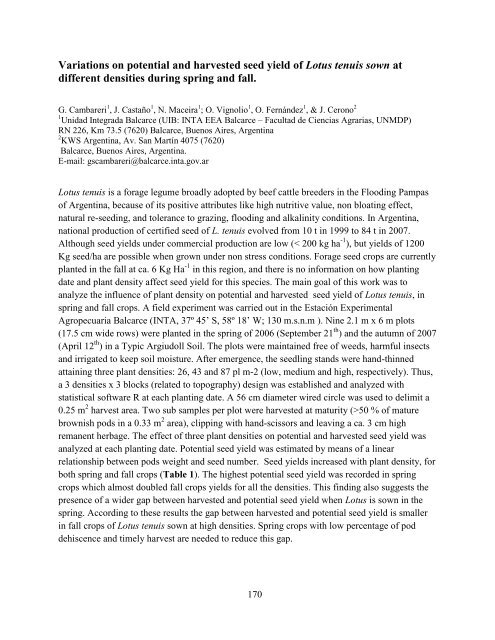Texas, USA 2010 - International Herbage Seed Group
Texas, USA 2010 - International Herbage Seed Group
Texas, USA 2010 - International Herbage Seed Group
You also want an ePaper? Increase the reach of your titles
YUMPU automatically turns print PDFs into web optimized ePapers that Google loves.
Variations on potential and harvested seed yield of Lotus tenuis sown atdifferent densities during spring and fall.G. Cambareri 1 , J. Castaño 1 , N. Maceira 1 ; O. Vignolio 1 , O. Fernández 1 , & J. Cerono 21 Unidad Integrada Balcarce (UIB: INTA EEA Balcarce – Facultad de Ciencias Agrarias, UNMDP)RN 226, Km 73.5 (7620) Balcarce, Buenos Aires, Argentina2 KWS Argentina, Av. San Martín 4075 (7620)Balcarce, Buenos Aires, Argentina.E-mail: gscambareri@balcarce.inta.gov.arLotus tenuis is a forage legume broadly adopted by beef cattle breeders in the Flooding Pampasof Argentina, because of its positive attributes like high nutritive value, non bloating effect,natural re-seeding, and tolerance to grazing, flooding and alkalinity conditions. In Argentina,national production of certified seed of L. tenuis evolved from 10 t in 1999 to 84 t in 2007.Although seed yields under commercial production are low (< 200 kg ha -1 ), but yields of 1200Kg seed/ha are possible when grown under non stress conditions. Forage seed crops are currentlyplanted in the fall at ca. 6 Kg Ha -1 in this region, and there is no information on how plantingdate and plant density affect seed yield for this species. The main goal of this work was toanalyze the influence of plant density on potential and harvested seed yield of Lotus tenuis, inspring and fall crops. A field experiment was carried out in the Estación ExperimentalAgropecuaria Balcarce (INTA, 37º 45‟ S, 58º 18‟ W; 130 m.s.n.m ). Nine 2.1 m x 6 m plots(17.5 cm wide rows) were planted in the spring of 2006 (September 21 th ) and the autumn of 2007(April 12 th ) in a Typic Argiudoll Soil. The plots were maintained free of weeds, harmful insectsand irrigated to keep soil moisture. After emergence, the seedling stands were hand-thinnedattaining three plant densities: 26, 43 and 87 pl m-2 (low, medium and high, respectively). Thus,a 3 densities x 3 blocks (related to topography) design was established and analyzed withstatistical software R at each planting date. A 56 cm diameter wired circle was used to delimit a0.25 m 2 harvest area. Two sub samples per plot were harvested at maturity (>50 % of maturebrownish pods in a 0.33 m 2 area), clipping with hand-scissors and leaving a ca. 3 cm highremanent herbage. The effect of three plant densities on potential and harvested seed yield wasanalyzed at each planting date. Potential seed yield was estimated by means of a linearrelationship between pods weight and seed number. <strong>Seed</strong> yields increased with plant density, forboth spring and fall crops (Table 1). The highest potential seed yield was recorded in springcrops which almost doubled fall crops yields for all the densities. This finding also suggests thepresence of a wider gap between harvested and potential seed yield when Lotus is sown in thespring. According to these results the gap between harvested and potential seed yield is smallerin fall crops of Lotus tenuis sown at high densities. Spring crops with low percentage of poddehiscence and timely harvest are needed to reduce this gap.170












